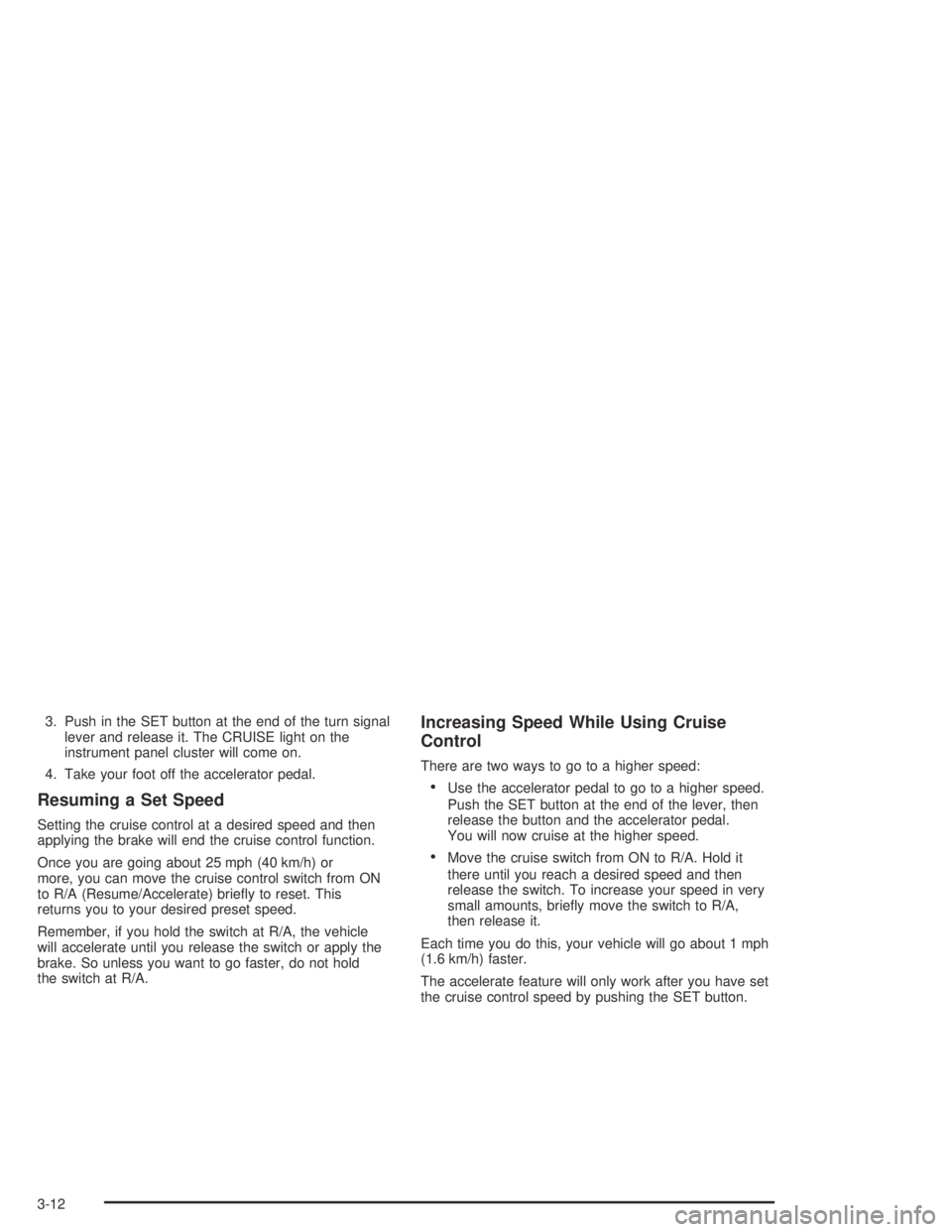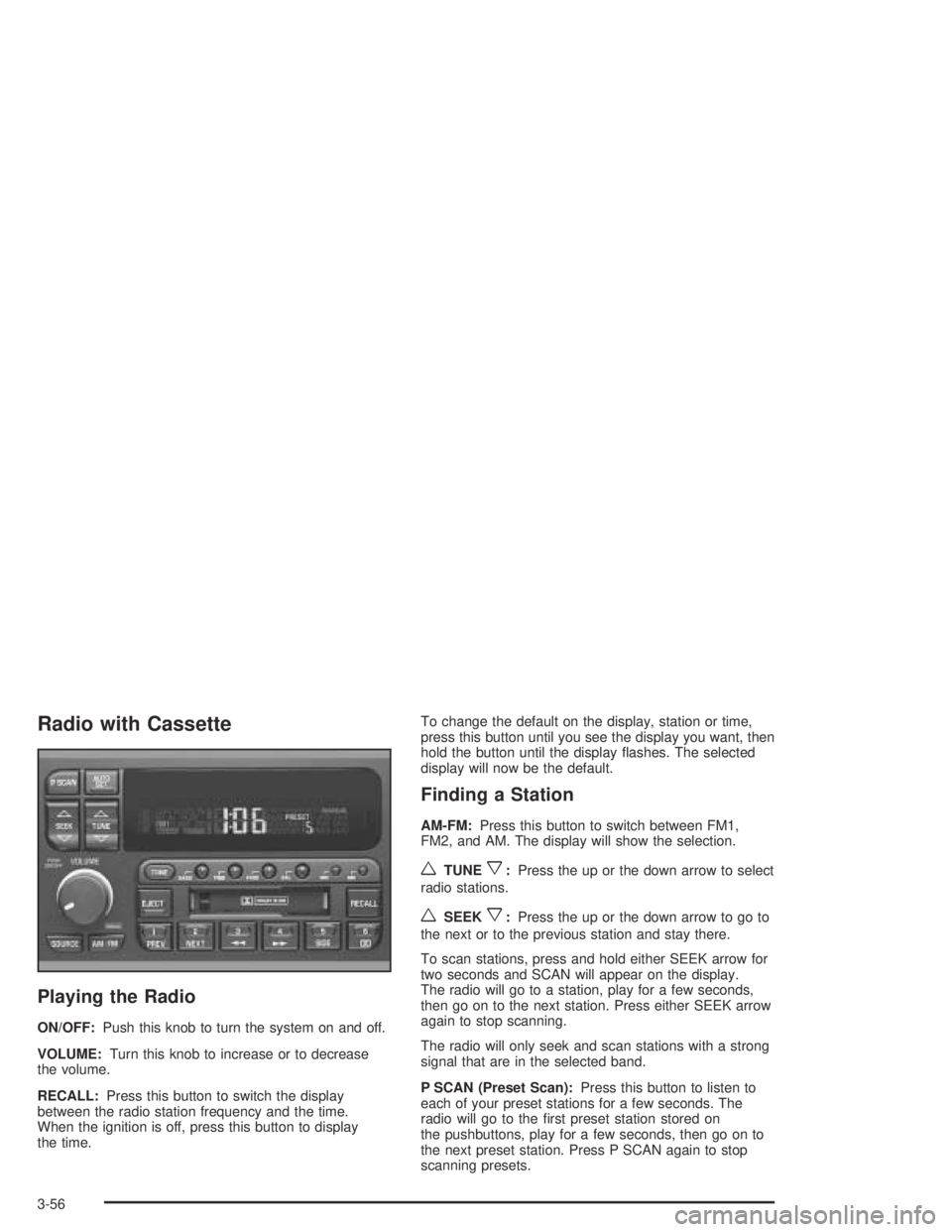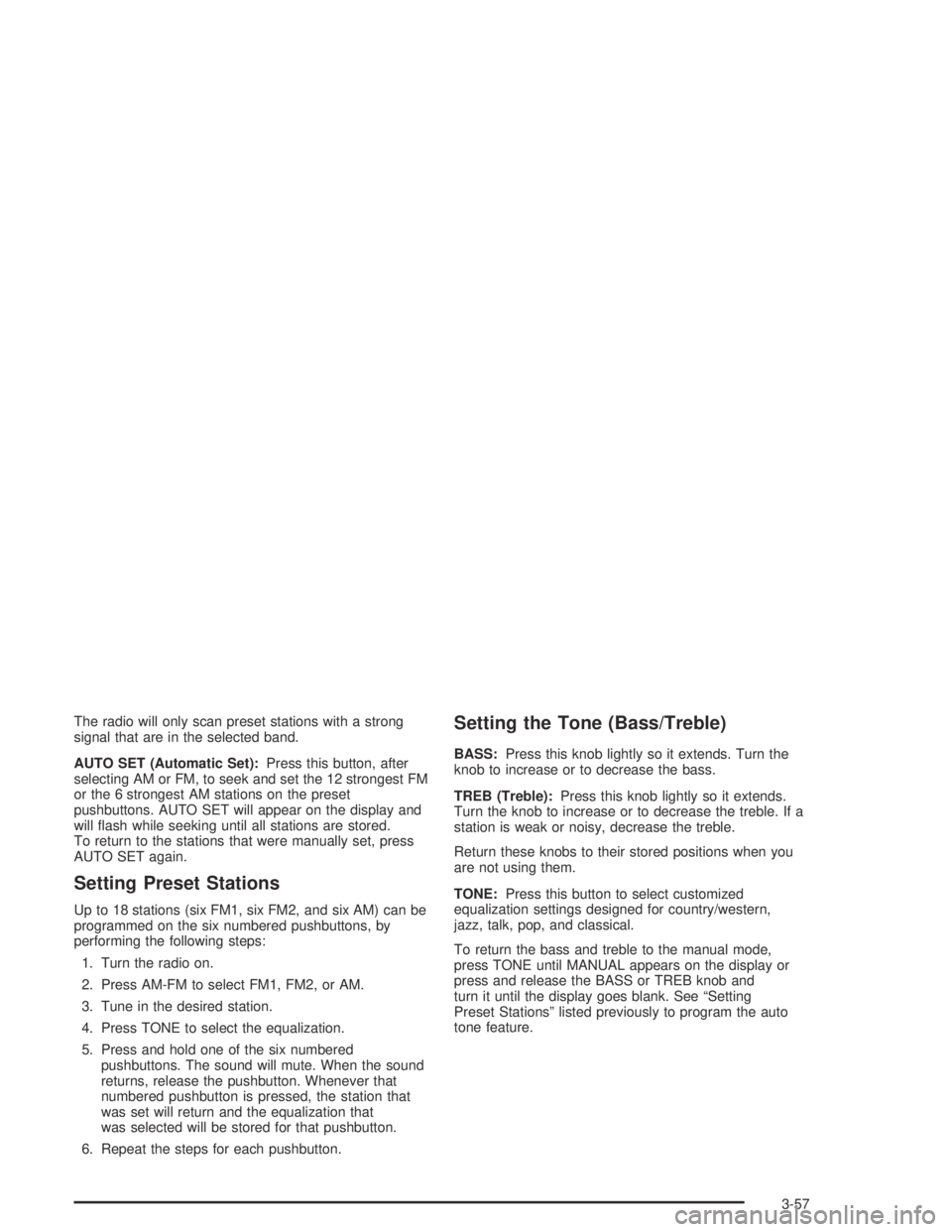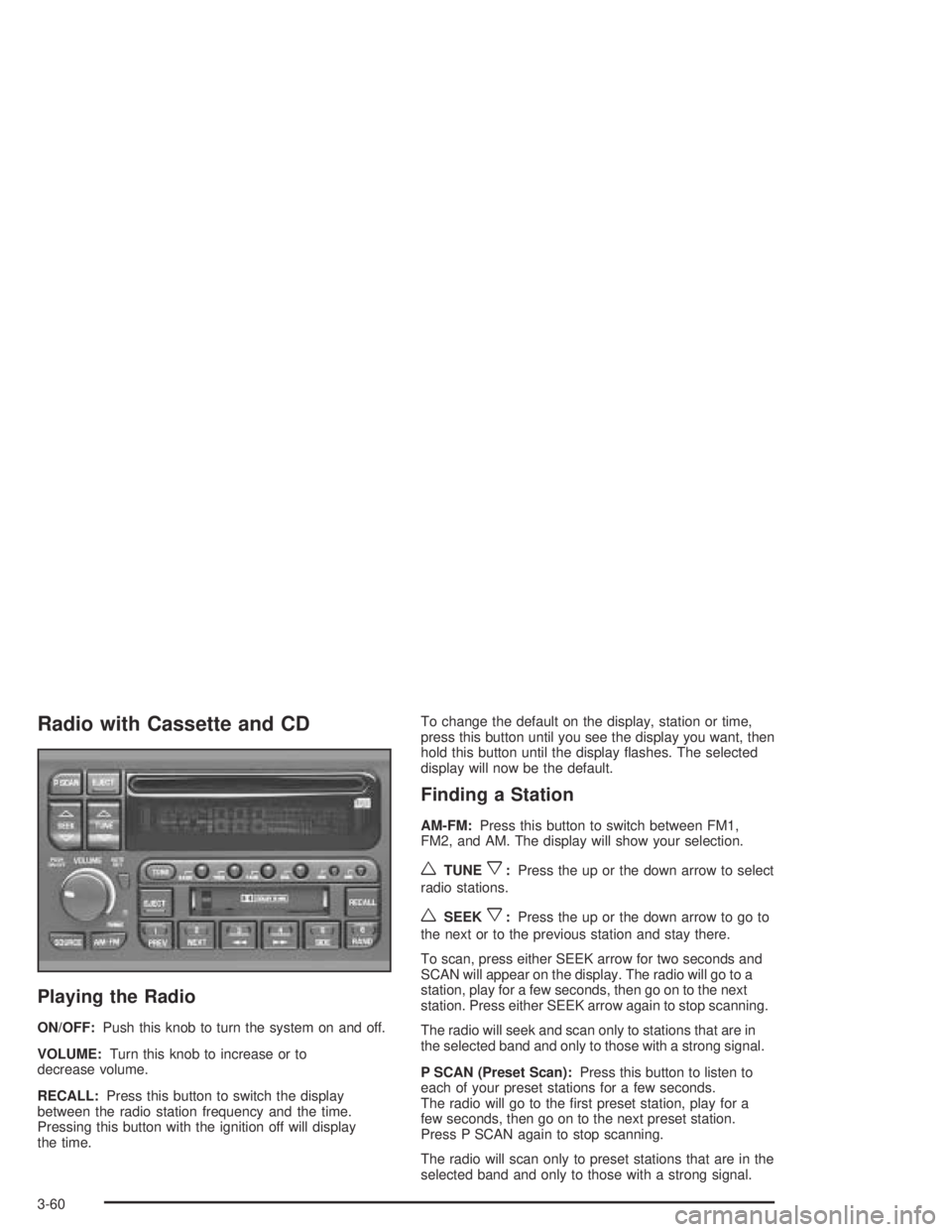2005 BUICK PARK AVENUE turn signal
[x] Cancel search: turn signalPage 122 of 388

If your vehicle is equipped with the Head-Up Display
(HUD), an arrow will also appear in the display area to
indicate the direction of the turn or lane change.
SeeHead-Up Display (HUD) on page 3-19for
more information.
You may also have an arrow in the outside mirror that
�ashes when the turn signal is used. SeeOutside Power
Mirrors on page 2-37for more information.
To signal a lane change, just raise or lower the lever
until the arrow starts to �ash. Hold it there until you
complete your lane change. The lever will return by itself
when you release it.
As you signal a turn or a lane change, if the arrows
�ash at twice the normal rate, this may indicate that a
signal bulb may be burned out and other drivers will not
see your turn signal. If a bulb is burned out, replace
it to help avoid an accident.
If the arrows do not go on at all when you signal a turn,
check the fuse and check for burned-out bulbs. See
Fuses and Circuit Breakers on page 5-92.
If you have a trailer towing option with added wiring for
the trailer lamps, the signal indicator will �ash even
if a turn signal bulb is burned out. Check the front and
rear turn signal lamps regularly to make sure they
are working. You do not need to add a different �asher.Turn Signal On Chime
If your turn signal is left on for more than three-quarters
of a mile (1.2 km), a chime will sound at each �ash
of the turn signal. To turn off the chime, move the turn
signal lever to the off position.
Headlamp High/Low-Beam Changer
To change the headlamps from low beam to high
beam or high beam to low beam, pull the turn signal
lever toward you and release it.
While the high beams are
on, this light located on the
instrument panel cluster
will also be on.
If your vehicle is equipped with the Head-Up
Display (HUD), this symbol will also appear in the
display area to indicate the high beams are on.
SeeHead-Up Display (HUD) on page 3-19for
more information.
3-8
Page 123 of 388

Flash-to-Pass
This feature lets you use the high-beam headlamps to
signal the driver in front of you that you want to pass. It
works even if your headlamps are off.
Pull the turn signal lever toward you brie�y to
�ash-to-pass.
If the headlamps are off or on low beam, the high-beam
headlamps will turn on. They will stay on as long as
you hold the lever toward you and the high-beam
indicator on the instrument panel cluster will come on.
Windshield Wipers
The windshield wipers are controlled by turning the
band marked WIPER.
OFF:Turn the band to OFF to turn the wipers off.
MIST:For a single wiping cycle, turn the band to MIST.
Hold it there until the wipers start, then let go. The
wipers will stop after one cycle. If you want more cycles,
hold the band on MIST longer.
LO (Low Speed):Turn the band to LO for steady
wiping at a slow speed.
HI (High Speed):Turn the band to HI for steady wiping
at a high speed.The wiper speed may be set for a long or short delay
between wipes. Turn the band to choose the delay time.
The closer to LO, the shorter the delay.
Heavy snow or ice can overload your wiper motor. A
circuit breaker will stop the motor until it cools.
Clear away snow or ice to prevent an overload.
Keep in mind that damaged wiper blades may prevent
you from seeing well enough to drive safely. To
avoid damage, be sure to clear ice and snow from the
wiper blades before using them. If your blades do
become damaged, get new blades or blade inserts.
Rainsense™ II Wipers
If your vehicle has this feature, the moisture sensor is
mounted on the interior of the windshield below the
rearview mirror and is used to automatically operate the
wipers. This system operates by monitoring the
amount of moisture build-up on the windshield. Wipes
occur as needed to clear the windshield depending
on the driving conditions and the sensitivity setting. In
light rain or snow, fewer wipes will occur. In heavy
rain or snow, wipes will occur more frequently.
The system will operate in the delay, low speed and
high speed modes. If the system is left on for long
periods of time, occasional wipes may occur without any
moisture on the windshield. This is normal and
indicates that the Rainsense™ system is active.
3-9
Page 126 of 388

3. Push in the SET button at the end of the turn signal
lever and release it. The CRUISE light on the
instrument panel cluster will come on.
4. Take your foot off the accelerator pedal.
Resuming a Set Speed
Setting the cruise control at a desired speed and then
applying the brake will end the cruise control function.
Once you are going about 25 mph (40 km/h) or
more, you can move the cruise control switch from ON
to R/A (Resume/Accelerate) brie�y to reset. This
returns you to your desired preset speed.
Remember, if you hold the switch at R/A, the vehicle
will accelerate until you release the switch or apply the
brake. So unless you want to go faster, do not hold
the switch at R/A.
Increasing Speed While Using Cruise
Control
There are two ways to go to a higher speed:
Use the accelerator pedal to go to a higher speed.
Push the SET button at the end of the lever, then
release the button and the accelerator pedal.
You will now cruise at the higher speed.
Move the cruise switch from ON to R/A. Hold it
there until you reach a desired speed and then
release the switch. To increase your speed in very
small amounts, brie�y move the switch to R/A,
then release it.
Each time you do this, your vehicle will go about 1 mph
(1.6 km/h) faster.
The accelerate feature will only work after you have set
the cruise control speed by pushing the SET button.
3-12
Page 129 of 388

Daytime Running Lamps
Daytime Running Lamps (DRL) can make it easier for
others to see the front of your vehicle during the
day. DRL can be helpful in many different driving
conditions, but they can be especially helpful in the short
periods after dawn and before sunset. Fully functional
daytime running lamps are required on all vehicles
�rst sold in Canada.
A light sensor on top of the instrument panel monitors
the exterior light level for the operation of DRL and
Twilight Sentinel
®, so be sure it is not covered.
The DRL system will make your low-beam headlamps
come on at reduced brightness in daylight when
the following conditions are met:
The ignition is on.
The exterior lamps control is off.
The transaxle is not in PARK (P).
When DRL are on, only your low-beam headlamps will
be on. The parking lamps, taillamps, sidemarker
and other lamps will not be on. Your instrument panel
will not be lit up either.When it is dark enough outside, your low-beam
headlamps will be at full brightness. The other lamps
that turn on with your headlamps will also turn on. When
it is bright enough outside, the regular lamps will turn
off, and your low-beam headlamps change to the
reduced brightness of DRL.
To idle your vehicle with the DRL off, shift the transaxle
into PARK (P). The DRL will stay off until you shift
out of PARK (P).
To turn off all exterior lighting at night when you are
parked, turn off the exterior lamp control and slide the
Twilight Sentinel
®control all the way to the left.
When released, the control will return to the Twilight
Sentinel
®minimum delay position and the lights will
turn off.
As with any vehicle, you should turn on the regular
headlamp system when you need it.
Cornering Lamps
The cornering lamps come on when the headlamps
or parking lamps are on and you signal a turn with
the multifunction lever. They provide more light
for cornering.
3-15
Page 134 of 388

The information may be displayed in English or metric
units and appears as a re�ection in the windshield.
The HUD consists of the following information:
Speedometer Reading
Turn Signal Indicators
High-Beam Headlamp Indicator
CHECK GAGES Message
The HUD shows these images when they are lighted on
the instrument panel cluster.Be sure to continue scanning your displays, controls
and driving environment just as you would in a vehicle
without HUD. If you never look at your instrument
panel, you may not see something important, such as a
warning light.
Notice:If you try to use the HUD image as a
parking aid, you may misjudge the distance and
damage your vehicle. Do not use the HUD image as
a parking aid.
The HUD controls
are located in the
overhead console.
1. Start your engine and slide the HUD dimmer switch
all the way up.
The brightness of the HUD image is determined by
whether the headlamps are on or off, and where
you have the HUD dimmer switch set.
3-20
Page 170 of 388

Radio with Cassette
Playing the Radio
ON/OFF:Push this knob to turn the system on and off.
VOLUME:Turn this knob to increase or to decrease
the volume.
RECALL:Press this button to switch the display
between the radio station frequency and the time.
When the ignition is off, press this button to display
the time.To change the default on the display, station or time,
press this button until you see the display you want, then
hold the button until the display �ashes. The selected
display will now be the default.
Finding a Station
AM-FM:Press this button to switch between FM1,
FM2, and AM. The display will show the selection.
wTUNEx:Press the up or the down arrow to select
radio stations.
wSEEKx:Press the up or the down arrow to go to
the next or to the previous station and stay there.
To scan stations, press and hold either SEEK arrow for
two seconds and SCAN will appear on the display.
The radio will go to a station, play for a few seconds,
then go on to the next station. Press either SEEK arrow
again to stop scanning.
The radio will only seek and scan stations with a strong
signal that are in the selected band.
P SCAN (Preset Scan):Press this button to listen to
each of your preset stations for a few seconds. The
radio will go to the �rst preset station stored on
the pushbuttons, play for a few seconds, then go on to
the next preset station. Press P SCAN again to stop
scanning presets.
3-56
Page 171 of 388

The radio will only scan preset stations with a strong
signal that are in the selected band.
AUTO SET (Automatic Set):Press this button, after
selecting AM or FM, to seek and set the 12 strongest FM
or the 6 strongest AM stations on the preset
pushbuttons. AUTO SET will appear on the display and
will �ash while seeking until all stations are stored.
To return to the stations that were manually set, press
AUTO SET again.
Setting Preset Stations
Up to 18 stations (six FM1, six FM2, and six AM) can be
programmed on the six numbered pushbuttons, by
performing the following steps:
1. Turn the radio on.
2. Press AM-FM to select FM1, FM2, or AM.
3. Tune in the desired station.
4. Press TONE to select the equalization.
5. Press and hold one of the six numbered
pushbuttons. The sound will mute. When the sound
returns, release the pushbutton. Whenever that
numbered pushbutton is pressed, the station that
was set will return and the equalization that
was selected will be stored for that pushbutton.
6. Repeat the steps for each pushbutton.
Setting the Tone (Bass/Treble)
BASS:Press this knob lightly so it extends. Turn the
knob to increase or to decrease the bass.
TREB (Treble):Press this knob lightly so it extends.
Turn the knob to increase or to decrease the treble. If a
station is weak or noisy, decrease the treble.
Return these knobs to their stored positions when you
are not using them.
TONE:Press this button to select customized
equalization settings designed for country/western,
jazz, talk, pop, and classical.
To return the bass and treble to the manual mode,
press TONE until MANUAL appears on the display or
press and release the BASS or TREB knob and
turn it until the display goes blank. See “Setting
Preset Stations” listed previously to program the auto
tone feature.
3-57
Page 174 of 388

Radio with Cassette and CD
Playing the Radio
ON/OFF:Push this knob to turn the system on and off.
VOLUME:Turn this knob to increase or to
decrease volume.
RECALL:Press this button to switch the display
between the radio station frequency and the time.
Pressing this button with the ignition off will display
the time.To change the default on the display, station or time,
press this button until you see the display you want, then
hold this button until the display �ashes. The selected
display will now be the default.
Finding a Station
AM-FM:Press this button to switch between FM1,
FM2, and AM. The display will show your selection.
wTUNEx:Press the up or the down arrow to select
radio stations.
wSEEKx:Press the up or the down arrow to go to
the next or to the previous station and stay there.
To scan, press either SEEK arrow for two seconds and
SCAN will appear on the display. The radio will go to a
station, play for a few seconds, then go on to the next
station. Press either SEEK arrow again to stop scanning.
The radio will seek and scan only to stations that are in
the selected band and only to those with a strong signal.
P SCAN (Preset Scan):Press this button to listen to
each of your preset stations for a few seconds.
The radio will go to the �rst preset station, play for a
few seconds, then go on to the next preset station.
Press P SCAN again to stop scanning.
The radio will scan only to preset stations that are in the
selected band and only to those with a strong signal.
3-60